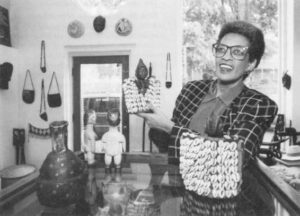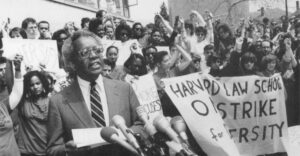Lee Daniels
- 1990

Fellowship Title:
- African Americans in Higher Education
Fellowship Year:
- 1990

The Future of Black Colleges and Universities
LINCOLN UNIVERSITY, PA.-Strolling across Lincoln University’s bucolic campus, set in southeastern Pennsylvania roughly equidistant from Baltimore, Philadelphia, and Wilmington, Delaware, tempts a visitor to populate walkways, classrooms, playing fields, and the chapel with some of its most famous alumni-Langston Hughes, the poet and playwright; Kwame Nkrumah, the first president of Ghana; Supreme Court Justice Thurgood Marshall, among others-and dwell upon its storied past. But Niara Sudarkasa, installed as Lincoln’s first woman president four years ago, spends her time planning the Lincoln of the 1990s. Her strategy is to use Lincoln’s historic importance to black America and the African Diaspora as the cornerstone of its future. Students block the main entrance to Lincoln University near Oxford, Pa., in early October. Officials there cancelled classes in the wake of the disturbance. (AP/Wide World Photos) “By the year 2000 Lincoln has to be one of the best small colleges in the land,” she says, sitting in her light-filled office at Vail Hall, the college’s old library, now an administration building near the formal entrance to the campus. “Its

Intolerance on Campus
After taping the poster announcing the spring activities of the black student association to his door in Wright Hall, Timothy Rey had gone to sleep around one o’clock that Saturday morning, his freshman year at the University of Indiana at Bloomington. When he opened his dormitory-room door at nine o’clock, heading for breakfast, only charred fragments of the poster remained. During the eight hours he slept one, or more than one, of his residence-hall neighbors had walked up to his door on the long corridor and burned it. “I didn’t even wake up, they were so quiet,” he says, recalling that morning, three years ago, “and I didn’t smell anything. I didn’t know about it until I opened my door.” Rey alerted friends and campus officials, who launched an investigation (the culprits were never found)-and that night he returned to sleep in his dormitory room. “People were surprised I went back to my room,” he remembers. “But I wasn’t scared for myself. It was my room, and I wasn’t going to be driven off.” By

The Push for Diversity in America’s White Male Faculties
Until recently, the broad debate over race relations at the nation’s colleges and universities focused largely on students. No longer. Pushed by a series of dramatic events during the past year, that often fractious discussion has now expanded to include those who teach them as well: the faculty. In doing so, it has become clear that the controversy erupting anew over the meaning and practice of affirmative action in higher education involves matters far more profound than arguing over the gathering, as if like Noah, of mere appropriate numbers of diverse peoples at this college or that university. At deeper levels, it involves such things as exploring what the concepts of pluralism and meritocracy mean in a multiracial society. Also, what use should be made of standards, which are not immutable, but established and applied by human beings. And what standards should in this or that instance take precedence? And how to negotiate the tension that exists in pluralistic settings between the rights of individuals and the no less real, but largely unacknowledged, rights of
